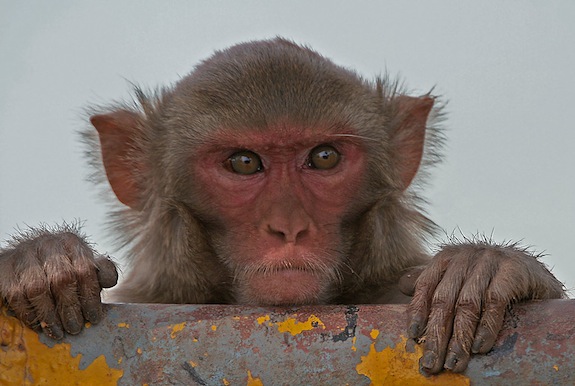Scientists Manipulate Brainwaves of Cocaine-Addled Monkeys to Improve Decision-Making
By stimulating neural activity with electrodes, researchers boosted the mental skills of rhesus monkeys under the influence of cocaine
![]()

By stimulating neural activity with electrodes, researchers boosted the mental skills of rhesus monkeys under the influence of cocaine. Image via Wikimedia Commons/J.M. Garg
Over the past year, we’ve seen the invention of increasingly sophisticated prosthetic limbs, ears and eyes—ideas and inventions that once seemed so fanciful as to belong to the realm of science fiction. Now, a team of scientists at Wake Forest University in North Carolina is going one step further, working on developing a prosthesis for the most complex organ of all: the mind.
As revealed in a paper published today in the Journal of Neural Engineering, the researchers created a way to manipulate the neural activity of rhesus monkeys to assist them with decision-making when their cognitive abilities were impaired due to the administration of cocaine. The scientists say their research could someday lead to a new way of assisting people who have diminished cognitive ability to disease or injury.
To establish a baseline for the monkeys’ decision-making abilities, the researchers trained them to execute a simple matching task on a computer. As each of the five monkeys used in the study looked at a computer screen, they were shown a single clip-art image, then the screen went blank for a minute or two. Afterward, the original picture came back, along with one to seven other images.
At the same time, the position of the monkeys’ arms on the countertop in front of the computer was tracked via a camera that detected UV light, which bounced off of a special reflector affixed to the back of the monkeys’ hands. The position of their hands, as detected by the camera, was digitized and fed into the computer, so when they moved their hands, a cursor on the computer screen moved, as though they were holding a mouse.
When the images came back onto the computer screen after the blank interval, if the monkeys moved the cursor over the original picture they’d been shown, they were rewarded with a drop of juice via a sipper situated near their mouths. Over the course of several months, each monkey got the hang of the task and trained until they were able to select the correct image 40 to 75 percent of the time, depending on the number of photos shown.
While they were doing the matching, though, the researchers were closely monitoring the monkeys’ neural patterns with recording cylinders that had been implanted in the animals’ prefrontal cortex, an area of the brain known to be active during decision-making tasks. The scientists discovered that the same neural activity patterns reliably occurred in this area whenever the monkeys successfully completed the task and less frequently when the monkeys picked the wrong picture.
Next, things got interesting: As the monkeys looked at the images and sipped juice, the researchers surreptitiously injected each one with cocaine. Because the drug is known to disrupt the sort of continued concentration and decision-making skills necessary to getting the computer matching task correct, the monkeys’ success rates predictably dwindled, and they picked the correct image 13 percent less frequently than before they were administered cocaine.
When the researchers used the electrodes they had previously implanted in the monkeys’ brains–located in the precise locations inside the prefrontal cortex that had been firing reliably when they correctly matched the image–to later trigger those neurons, replicating the firing patterns, the results were dramatic.
“The prosthetic device is like ‘flipping a switch’ to turn on a decision in real time,” said Sam Deadwyler, a professor of physiology and pharmacology at Wake Forest and one of the study’s authors. Under the influence of cocaine, the prosthesis restored and even improved as compared with the baseline, with the monkeys selecting the correct image 10 percent more frequently than before.
“Based on the findings of this study, we hope in the future to develop an implantable neuroprosthesis that could help people recover from cognitive deficiencies due to brain injuries,” said Wake Forest professor Robert E. Hampson, the lead author of the study.
It’s conceivable, though, that the temptation of a neural prostheses could be strong enough to someday appeal to a different crowd—instead of those who suffered a stroke or lesion, people simply looking for a competitive edge. It might sound far-fetched, but in an age of “neuroenhancing” drugs and ever-increasing plastic surgery, there’s no telling where the concept of neural prosthetics might go.
/https://tf-cmsv2-smithsonianmag-media.s3.amazonaws.com/accounts/headshot/joseph-stromberg-240.jpg)
/https://tf-cmsv2-smithsonianmag-media.s3.amazonaws.com/accounts/headshot/joseph-stromberg-240.jpg)